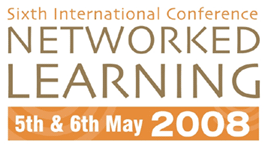

Supporting and Enhancing Undergraduate Learning with m-learning tools: an exploration and analysis of the potential of Mobile Phones and SMS
Geraldine Jones, Gabriele Edwards, Alan Reid
Department of Education, University of Bath
g.m.jones@bath.ac.uk, g.edwards@bath.ac.uk, a.d.reid@bath.ac.uk
Abstract
New undergraduate students face a variety of challenges associated with
making the transition to higher education (HE), including the removal
of structures provided by the regulations and syllabus in schools and
colleges, and family support. Academic demands, expositive teaching approaches,
reduced interaction or personal contact with tutors, and a requirement
for independent study can result in a difficult first semester for some
students. The latest generation of undergraduates live and have grown
up in a highly connected world which, it is claimed, causes them to develop
fundamentally different ways of thinking and information processing from
their predecessors. For example, today's students are thought of
as inhabiting a complex array of communication networks mediated by an
evolving ecology of mobile and non-mobile devices. The 'niche'
occupied by the mobile phone is of particular interest owing to its prevalence
across the student population and the growing functionality that they
support.
It is claimed that mobile learning (m-learning) opportunities can offer
alternative or complementary modes of learning that more closely match
these students' preferences Many pilot or demonstrator (proof of
concept) m-learning projects have illuminated the potential for mobile
devices to support learning and change in HE approaches. Typically these
might involve the use of high specification devices running specialist
software packages and/or focus on using mobile devices as part of highly
student centred learning experiences located remote from more traditional
learning contexts. Few studies have explored how to harness existing infrastructures
of personal mobile devices or the protocols of social communication for
academic purposes. Furthermore, little is known about how mobile mediated
communication might compliment more traditional learning and teaching
contexts (e.g. lectures, seminars and more recently and increasingly,
Virtual Learning Environments (VLEs)).
This paper seeks to add knowledge in these areas by reporting and reflecting on a case study which investigates how the academic and personal development of first year students (n=81) on an undergraduate sports education degree can be supported and enhanced by m-learning. Drawing on Moore's theory of transactional distance we aimed to reduced the 'distance' between tutor and students and students and the course content. More specifically, by structuring inter-session study time using group learning activities we sought to establish learning networks that more effectively support the student experience on a core unit of study. In addition, we sought to harness the communication cultures and skills of these 'digital native'students, using mobile phones and SMS.
We review findings from a student survey about the extent of mobile phone
ownership, the capability of the devices, the range of contracts, and
student views about the potential use of their phones as tools for learning.
The survey informed the initial design of a set of group learning activities
giving structure to out-of-session study while facilitating greater connectivity
between the students and their course, and between the students and the
tutor. Asynchronous tools (forums and wikis) in the VLE were used in concert
with mobile communication, managed through a bulk texting service. We
report on the outcomes of our formative and summative evaluations which
yielded both qualitative and quantitative data from a variety of sources:
focus groups, an online discussion forum, student questionnaire, access
statistics from the Moodle VLE and bulktexting service, and the tutor's
reflective journal. We discuss our early findings linked to the outcomes
of our evaluation, specifically three key issues: how texting can support
student time management; how the SMS communication can extend the tutor's
voice; and to what extent we were successful in appropriating students'
personal mobile communication infrastructures. Finally we discuss how
this study addresses some of the challenges associated with the perceived
increase in transactional distance caused by physical, cognitive and digital
remoteness between students and their teachers.
Full Paper - .pdf
| About NLC |
2008 Conference Papers
| Conference Committee| Keynote
Speakers
| Papers from previous NL conferences |Research Seminars| Current Conference
| Sponsors | Contact
|
